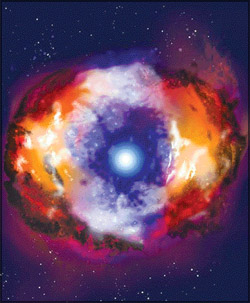It's time to see stars!
 One
of the most beautiful sights in nature is the night sky. Most of you
must be familiar with the famous nursery rhyme 'Twinkle, twinkle little
star...' As the rhyme states, the stars certainly do look like little
diamonds, shining brightly in a velvety black sky. One
of the most beautiful sights in nature is the night sky. Most of you
must be familiar with the famous nursery rhyme 'Twinkle, twinkle little
star...' As the rhyme states, the stars certainly do look like little
diamonds, shining brightly in a velvety black sky.
The bright planets that wander among the stars and long-tailed comets
that come and go, are indeed fascinating sights. How many of you have
indulged in star-gazing or even visited the planetarium and looked up at
the vast expanse of space, twinkling with stars and lit up by other
celestial bodies?
There are millions of stars, but we cannot see all of them with our
normal or naked eyes. We need the
|

Supernova explosion |
assistance of powerful telescopic lenses to see them. However,
if you look closely at the night sky, you will notice that some stars
sparkle more and are much brighter than the others. These bright stars
make patterns that you can recognize every time you see them. These star
patterns are known as constellations.
Whenever you look up into the night sky, you will notice that the
constellations seem to be moving across the sky from east to west, just
like the Sun does during the day. How or why do they move?
Ancient astronomers were of the view that the stars moved because
they were fixed on the inside of the celestial sphere, which spun around
Earth that was still. We know today that the opposite is true; it is the
Earth and not the stars that are moving around. As the Earth spins round
in space from west to east, it makes the stars appear to travel in the
opposite direction.
Why the entire world can't see the
same stars
As stars are up above us in space, you may be of the view that
everybody around the world see the same stars. You are wrong. As our
planet Earth rotates on its north-south axis, we can only see the stars
in the sky above our hemisphere.
For example, people in the far north can always see the constellation
of stars known as the Plough, but those in the far south can never see
it, unless of course they travel to that part of the world.
In the same way, those living in the far south will always see the
Southern Cross. However, those in the Equator can see almost all the
stars visible to the naked eye, at some time of the year.
Major constellations and zodiac signs
|

Sparkling stars |
There are 12 major constellations that have been identified. The six
constellations in the Northern hemisphere are Pegasus, Perseus, Pole
Star, Plough (or Little Bear), Great Bear and Leo (the Lion). The six
constellations in the Southern hemisphere are; Aquarius (the
Water-bearer), Orion (the Hunter), Scorpio (the Scorpion), Southern
Cross, Hydra (Water Snake) and Libra (Scales).
Now, as you read these names, you will instantly connect some of them
to the zodiac signs in astrology. These zodiac signs, also called star
signs, are important in astrology because astrologers believe that human
lives are affected by the stars.
What are stars and how hot are they?
Don't be fooled by the tiny, bright specks that twinkle in the
night... They are not what they seem. Stars are huge balls of searing
gas. They are in fact great globes of very hot gas with varying
temperatures. Astronomers can tell the temperature of a star by the
colour and brightness of the light it gives out.
Yellowish stars, like our very own Sun, have a temperature of about
5,500 degrees Celsius. This compares with about 3,000 degrees Celsius
for a dim red star, to 30,000 degrees Celsius for a bright, blue-white
star.
We cannot know the exact size of all the stars in our galaxy, but we
can certainly measure our own star, the Sun. It is nearly 1,400,000
kilometres across. Astronomers do manage to work out the size of some
stars.
They have discovered that there are stars which are smaller than the
Sun, and also many stars which are much larger. It is due to the fact
that astronomers have discovered red giant stars and super giant stars,
tens of times bigger than the Sun, that they call our star, a dwarf.
Some super giants are said to be about 400 million kilometres across!
Why stars twinkle
Why do you think stars twinkle? Is it because they change their
brightness all the time or because we see them that way? Even though it
seems as if stars do not give out a steady light and change brightness
all the time, in reality they do shine steadily.
The reason we see them as twinkling stars is due to air currents.
These air currents in the Earth's atmosphere make the light from the
star bend in all directions. Some of this light gets into our eyes and
|

Orion the Hunter |
some is bent away. So, to us on Earth, the stars seem to
twinkle all the time. Isn't it fascinating?
Do stars live forever?
Most of you must have heard people say that the Sun will come to an
end some day. Well, that means, stars too die out. Just like all living
things, stars are born, they grow older and eventually die.
There are two different ways in which stars die. Now let's check out
one method first. After shining steadily for some time, the stars start
to swell up and turn into red giants.
Some of these red giants shrink into white dwarfs and finally end up
as black dwarfs. This is what is going to happen to our own Sun one day.
At the moment the Sun, which is believed to have been born about 5,000
million years ago, is giving us light and warmth.
But, in the future, it will swell up and become hotter, and the
Earth's oceans will boil away; life will end.
As the Sun becomes a red hot giant, Earth will be scorched to a
cinder.
The sun will gradually shrink again and become a white dwarf star,
about the size of Earth. It will end up as a black dwarf, like any other
star.
The other method stars die is by swelling up from a red giant to a
supergiant. As super giants are unstable, they collapse and blast
themselves to pieces in an explosion called a supernova. These are the
biggest explosions in the Universe. Supernova explosions are extremely
bright, as if a billion Suns have been put together.
A smaller star that explodes as a supernova ends its life as a tiny
star which is called a pulsar. There's so much fascinating things you
could learn not only about stars, but the entire universe. Don't fail to
hitch a ride on Space station and learn about the mysteries out
there..... |
